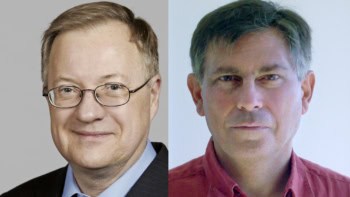Astronomers are closing in on the age of the universe. At a press conference yesterday the Hubble Space Telescope Key Project Team announced that its final value for the Hubble constant implies that the universe is 12 billion years old, plus or minus about one billion years. The team used the Hubble telescope to measure almost 800 Cepheid variable stars - pulsating stars that act as “standard candles” and therefore allow accurate measurements of distance - in 18 galaxies out to a distance of 65 million light years. A different analysis by Charles Lineweaver of the University of New South Wales in Sydney, Australia, suggests that the universe is 13.4 billion years old, plus or minus 1.6 billion years. Lineweaver’s result, which is based on measurements on the cosmic microwave and six other cosmological measurements, is published in Science tomorrow (Science 284 1503). The oldest stars in the universe are between 11 and 14 billion years old, which can be accommodated by the new age of the universe. Only recently some results had suggested that the universe was only 10 billion years old.
The Hubble team, led by Wendy Freedman of the Observatories of the Carnegie Institution of Washington, has spent the last eight years using the telescope to make more accurate measurements of the Hubble constant – the rate at which the universes expands. The team’s final result this is that the Hubble constant is 70 kilometres per second per megaparsec. (A megaparsec is 3.26 million light years). The uncertainty in the measurement is 10%. “After all these years, we are finally entering an era of precision cosmology, ” said Freedman.
To calculate the age of the universe from the Hubble constant it is necessary to know both the density of matter in the universe and the value of the cosmological constant. The Hubble team assumed that the density was critical – that is, high enough to eventually stop the expansion of the universe, but not enough to cause the universe to collapse back in on itself. If the cosmological constant is non-zero – as suggested by recent observations which suggest that the expansion of the universe is increasing with time – then the age would be greater.
Freedman and colleagues used the Hubble telescope to measure the brightness of Cepheid variables, well-known astronomical objects whose brightness waxes and wanes on a regular timescale. Astronomers have been able to associate this time variation with the total luminosity of the star. Once they have calculated the brightness of the star, the luminosity measured from the Earth is depends only on how far away it is (assuming that the star is not obscured by dust).
Lineweaver, on the other hand, combined recent independent measurements of the cosmic microwave background – the radiation left over from the Big Bang – with six other cosmological measurements to determine the Hubble constant, the density of matter in the universe and the cosmological constant. Whereas matter slows down the expanding universe, the cosmological constant represents a kind of antigravity force that speeds up the expansion. Einstein once famously called the cosmological constant his greatest blunder but recent observations by two international teams of astronomers suggest that it is non-zero.



